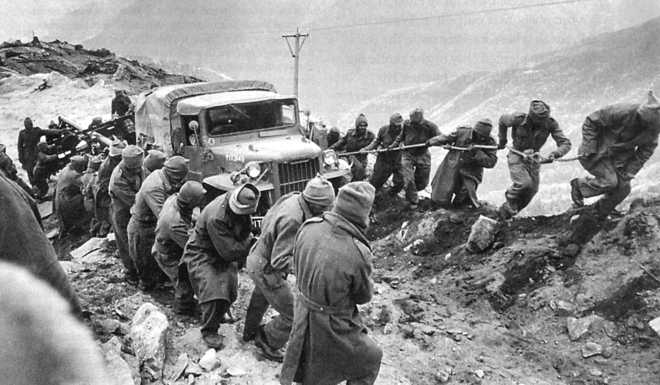1962 – A case of Chinese whispers
Ajay Banerjee
In the absence of an authentic public account, events leading to the month-long India-China war in 1962 have diametrically opposite and rather ‘conflicting versions’. Some blame India for being the aggressor, others blame China for having prepared for a war since 1959 and for being the aggressor.
Adding to the cauldron of conflicting versions are books written by key players of those times. B.N Mullick, the director Intelligence Bureau, wrote Chinese Betrayal: My Years with Nehru; Lt Gen B.M Kaul, the then commander of the Tezpur-based IV Corps, wrote The Untold Story; Brig DK Palit, the then Director Military Operations, penned the War in High Himalaya: The Indian Army in Crisis, 1962; Brig J.P Dalvi, the then Commander of the Army’s 7th Brigade, has his version of events Himalayan Blunder: The Curtain-Raiser to the Sino-Indian War of 1962.
All have looked at their own specific roles and are autobiographical accounts. In 2016, Shiv Kunal Verma, son of an Army Captain who fought the Sino-India war, wrote 1962: The War That Wasn’t. He pieced together yet another account that discusses the battle-scape and also the political scene.
Conflicting versions
A 1971 book India’s China War by Australia-based author Neville Maxwell kicked off the blame game by maintaining that Indian Prime Minister Jawaharlal Nehru had unleashed a ‘forward policy’ that ‘provoked’ China into a war (Oct 20, 1962 to Nov 23, 1962). Maxwell’s theory propagated in his book reinforces the thought that China was only defending its territory. British author Sir Alistar Lamb, who has authored three books, also presents a case against India.
Two other books have a diametrically opposite view maintaining that it was China, and not India that ‘provoked’ the war. Swedish Journalist Bertil Lintner’s China’s India War-Collision Course on the Roof of the World, and History of the Conflict with China — 1962, released for ‘restricted’ circulation by the Ministry of Defence (MoD) in March 1993, puncture the Maxwell-Lamb theory that has cast a shadow on the post-Independence thinking on the Sino-Indian conflict.
At the launch of his book in New Delhi in December last year Lintner had said, “Maxwell may have misjudged and most people do make that mistake”. His book goes on to detail that the decision to go to war with India had been taken in 1959 — the year Dalai Lama had arrived in India.
The MoD book, rebuts the Maxwell claim an a aggressive ‘forward policy’ — a decision taken by India in November 1961 — saying it was to restrict the Chinese to their claim-line of 1956 and stop claims over the new territory in 1960. Beijing had expanded its claim on another 5,100 sq km of territory in eastern Ladakh. It was to “prevent further infiltration into unoccupied areas of Ladakh”, says the book possessed by a miniscule number of Indians, but the same is again not in public domain being classified as ‘restricted’.
India and China have an un-demarcated boundary. Five attempts by the British between 1847 and 1914 did not yield results. At present the India-China special representatives are charged to tackle the boundary question.
Need to correct misperception of disgrace
The MoD book also debunks the ‘popular belief’ that India was totally ‘disgraced’ in the 1962 India-China War. It accepts the shortcomings, but tells how Indian troops held on in Ladakh, most notably at Rezang La in eastern Ladakh, just 5 km south-east of the hamlet of Chusul. “The Indian soldier was defeated but not disgraced in Ladakh,” it says, dispelling the notion.
Notably, the Chinese officially admit to 2,419 casualties (722 dead and 1,697 wounded). The figure is quite stunning given the situation in which each Indian position was asked to fight.
Henderson Brooks-Bhagat report apportions blames on Generals
A report on the war by Lt Gen Henderson Brooks and Brig (later Lt Gen) Prem Bhagat is classified even as Neville Maxwell put out portions of it on a website. New Delhi did not rebut him for this nor had it done in 1971 by a scholarly rebuttal of his earlier book hence allowing Maxwell’s one-sided interpretation to flourish.
The portions put out in public reveal that the government wanted a ‘forward policy’, but left the implementation to the generals. Gen B.M Kaul, overruled valid cautions presented by Lt Gen Daulet Singh, the Western Army Commander who had insisted that a forward move must have adequate troop numbers, combat support and logistics.
The belief that pushing forward would not encounter Chinese resistance came from the Intelligence Bureau. The Army’s earlier stated view that “the Chinese would resist by force any attempts to take back territory held by them,” was countered by B.N Mullick thus: “The Chinese would not react to our establishing new posts and that they were not likely to use force against any of our posts even if they were in a position to do so”.
The Army Headquarters had a wrong assessment of troops. It argued that China could not muster more than 5,000 troops facing eastern Ladakh even as Lt Gen Daulat Singh warned (correctly) on August 17, 1962 that Beijing had 15,000 troops.
Hindrance in accessing records
The Public Record Act 1993 does not entail automatic declassification of military records, and exemptions under the Right to Information Act 2005 are a deterrent for researchers. A war history cell at the Centre for Land Warfare Studies (CLAWS) produced a paper in 2016 titled A Historiographic Analysis of the Military History of Post-Independent India. Authored by Jaideep Chanda, it is candid: “An analysis of the military historical literature in India will primarily find personal accounts mostly written by retired Army officers”.









